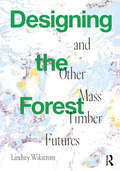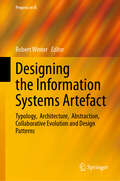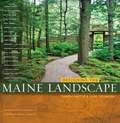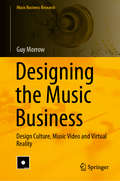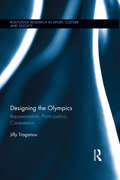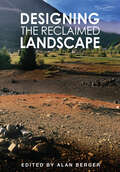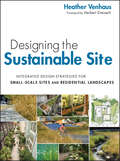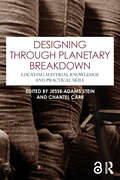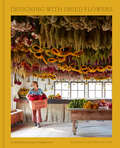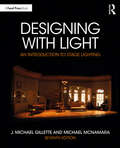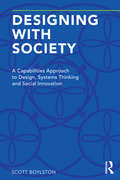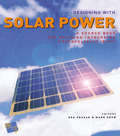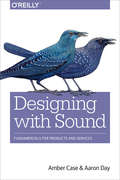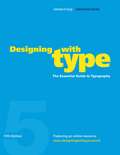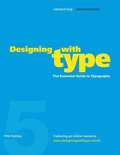- Table View
- List View
Designing the Exterior Wall: An Architectural Guide to the Vertical Envelope
by Linda BrockBy presenting the basics of building science along with a prescribed set of details, Designing the Exterior Wall helps you understand why buildings fail and how they can be made more durable through design. Author Linda Brock connects the science and aesthetics of building envelopes through the examination of a variety of construction and cladding types. She features details from real world projects in a variety of climates, successful and unsuccessful case studies, and checklists you can use on your own projects. Helps you reduce your liability by showing why building envelopes fail and how they can be designed to endure. Moves from theory to actual construction by including hundreds of building envelope details from a broad array of projects and climates. Integrates numerous contemporary case studies, including Frank Gehry's Experiential Music Center in Seattle (thin skins), Renzo Piano's Rue de Meaux housing in Paris (terra cotta cladding), and Mario Botta's San Francisco Museum of Modern Art (prefabricated brick panels). Designing the Exterior Wall is a must-have book, whether you're an architect or a student. Order your copy today.
Designing the Forest and other Mass Timber Futures
by Lindsey WikstromIf we want to continue existing on this earth, an era of renewable energy and materials is urgently needed. What role could mass timber, with its potential to replace concrete and steel, have in ensuring the planet’s survival? This book retraces wood’s passage from stewarded seed in the soil of forests, to harvested biomass, to laminated walls in a living room, through to its disassembly, pausing at each step in the supply chain of mass timber to consider the labor and economies involved, looking closely at the way wood is grown, sourced, and transported, and its impacts on the biodiversity of the forest and the health of our ecosystems. It explores why historically entrenched contexts of extractivism make such sensitive approaches difficult to cultivate across landscapes and industrial frameworks. Along the way, common assumptions about mass timber are debunked, including its fire performance, its strength, and its role in carbon sequestration. Having identified contemporary technical, cultural, and spiritual gaps preventing the transition towards a fully timber built environment, it outlines how we might move forward. A more sensitive species-based methodology is essential, with designers as choreographers of carbon, transferring and trading between forest, factory, site, and beyond. This will be an important read for anyone interested in our built environment and how to design it to be non-extractive, especially those with an interest in architecture, urbanism, forests, ecology, and timber, as well as students of architecture and design interested in the generative nature of materials and design processes.
Designing the Global City: Design Excellence, Competitions And The Remaking Of Central Sydney
by Robert Freestone Gethin Davison Richard HuThis text explores how architectural and urban design values have been co-opted by global cities to enhance their economic competitiveness by creating a superior built environment that is not just aesthetically memorable but more productive and sustainable. It focuses on the experience of central Sydney through its policy commitment to ‘design excellence’ and more particularly to mandatory competitive design processes for major private development. Framed within broader contexts that link it to comparable urban policy and design issues in the Asia-Pacific region and globally, it provides a scholarly but accessible volume that provides a balanced and critical overview of a policy that has changed the design culture, development expectations, public realm and skyline of central Sydney, raising issues surrounding the uneven distribution of benefits and costs, professional practice, representative democracy, and implications of globalization.
Designing the Information Systems Artefact: Typology, Architecture, Abstraction, Collaborative Evolution and Design Patterns (Progress in IS)
by Robert WinterThis book provides essential methodological guidance on IS artifacts to address key challenges in Design Science Research (DSR). As a foundation for understanding and categorizing DSR artifacts, it proposes a more differentiated, empirically justified DSR artifact typology. Additionally, it presents an artifact type-agnostic architecture model for DSR project knowledge, offering concrete recommendations for researchers and practitioners alike. As most DSR artifacts exist on a wide range of abstraction levels, an artifact type-agnostic perspective of abstraction is presented and a set of fundamental generalization and contextualization operations is proposed. The concept of managed evolution and insights from tension theory are used to propose a collaboration model, fostering effective interaction between researchers and practitioners in DSR. Finally, by associating empirically validated classes of functional requirements with solution classes, candidates for general constructional patterns are developed. All chapters share a contemporary understanding of DSR artifacts as complex combinations of IT, organizational, and use elements – ranging from algorithms to informal interventions in organizations. These artifacts are based on both descriptive knowledge and empirical justifications (or ideally both) and are exemplified by contextualized instantiations that solve situated problems in organizations or administrations. This book provides a unified and practical approach to advancing DSR, offering insights for both advanced academic researchers and industry practitioners whose work involves IS artifacts.
Designing the Maine Landscape
by Theresa Mattor Lucie TeegardebFrederick Law Olmsted and others saw the landscape as it was and enhanced it, instead of imposing rigid design upon it. Groundbreaking landscape architects Beatrix Farrand and Fletcher Steele, among others, were brought to Maine by patrons, and the resulting public parks, campuses, institutional grounds, and private estates remain a priceless legacy. Drawn from a 10-year survey conducted by the Maine Olmsted Alliance, this book showcases those landscapes and celebrates their history and legacy.
Designing the Megaregion: Meeting Urban Challenges at a New Scale
by Jonathan BarnettAs the US population grows—potentially adding more than 110 million people by 2050—cities and their suburbs will continue expanding, eventually meeting the suburbs of neighboring cities and forming continuous urban megaregions. There are now at least a dozen megaregions in the US, such as the one extending from Richmond, Virginia, to Portland, Maine, and the megaregion that runs from Santa Barbara through Los Angeles and San Diego, down to the Mexican border. In Designing the Megaregion, planning and urban design expert Jonathan Barnett takes a fresh look at designing megaregions. Barnett argues that planning megaregions requires ecological literacy and a renewed commitment to social equity in order to address the increasing pressure this growth puts on natural, built, and human resources. If current trends continue, new construction in megaregions will put additional stress on natural resources, make highway gridlock and airline delays much worse, and cause each region to become more separate and unequal. Barnett offers an incremental approach to designing at the megaregional scale that will help prepare for future economic and population growth. Designing the Megaregion explains how we can, and should, redesign megaregional growth using mostly private investment, without having to wait for large-scale, government initiatives and trying to create whole new governmental structures. Barnett explains practical initiatives for adapting development in response to a changing climate, improving transportation systems, and redirecting the forces that make megaregions very unequal places. There is an urgent need to begin designing megaregions, and Barnett offers a hopeful way forward using systems that are already in place.
Designing the Modern City: Urbanism Since 1850
by Eric MumfordA comprehensive new survey tracing the global history of urbanism and urban design from the industrial revolution to the present. Written with an international perspective that encourages cross-cultural comparisons, leading architectural and urban historian Eric Mumford presents a comprehensive survey of urbanism and urban design since the industrial revolution. Beginning in the second half of the 19th century, technical, social, and economic developments set cities and the world’s population on a course of massive expansion. Mumford recounts how key figures in design responded to these changing circumstances with both practicable proposals and theoretical frameworks, ultimately creating what are now mainstream ideas about how urban environments should be designed, as well as creating the field called “urbanism.” He then traces the complex outcomes of approaches that emerged in European, American, and Asian cities. This erudite and insightful book addresses the modernization of the traditional city, including mass transit and sanitary sewer systems, building legislation, and model tenement and regional planning approaches. It also examines the urban design concepts of groups such as CIAM (International Congresses of Modern Architecture) and Team 10, and their adherents and critics, including those of the Congress for the New Urbanism, as well as efforts toward ecological urbanism. Highlighting built as well as unbuilt projects, Mumford offers a sweeping guide to the history of designers’ efforts to shape cities.
Designing the Music Business: Design Culture, Music Video and Virtual Reality (Music Business Research)
by Guy MorrowThis book addresses the neglect of visual creativities and content, and how these are commercialised in the music industries. While musical and visual creativities drive growth, there is a lack of literature relating to the visual side of the music business, which is significant given that the production of meaning and value within this business occurs across a number of textual sites.Popular music is a multimedia, discursive, fluid, and expansive cultural form that, in addition to the music itself, includes album covers; gig and tour posters; music videos; set, stage, and lighting designs; live concert footage; websites; virtual reality/augmented reality technologies; merchandise designs; and other forms of visual content. As a result, it has become impossible to understand the meaning and value of music without considering its relation to these visual components and to the interrelationships between them. Using design culture theory, participant observation, interviews, case studies, and a visual methodology to explore the topic, this research-based book is a valuable study aid for undergraduate and postgraduate students of subjects including the music business, design, arts management, creative and cultural industries studies, business and management studies, and media and communications.
Designing the Olympics: Representation, Participation, Contestation (Routledge Research in Sport, Culture and Society)
by Jilly TraganouDesigning the Olympics claims that the Olympic Games provide opportunities to reflect on the relationship between design, national identity, and citizenship. The "Olympic design milieu" fans out from the construction of the Olympic city and the creation of emblems, mascots, and ceremonies, to the consumption, interpretation, and appropriation of Olympic artifacts from their conception to their afterlife. Besides products that try to achieve consensus and induce civic pride, the "Olympic design milieu" also includes processes that oppose the Olympics and their enforcement. The book examines the graphic design program for Tokyo 1964, architecture and urban plans for Athens 2004, brand design for London 2012, and practices of subversive appropriation and sociotechnical action in counter-Olympic movements since the 1960s. It explores how the Olympics shape the physical, legal and emotional contours of a host nation and its position in the world; how the Games are contested by a broader social spectrum within and beyond the nation; and how, throughout these encounters, design plays a crucial role. Recognizing the presence of multiple actors, the book investigates the potential of design in promoting equitable political participation in the Olympic context.
Designing the Reclaimed Landscape
by Alan BergerThe first practical yet in-depth exploration of how to reclaim the post-industrial landscape, this volume includes excellent case studies by practitioners and policy makers from around the US, giving first rate practical examples. The book addresses new thinking about landscape, which applies new techniques to the task of transforming outdated and disused post-extraction landscapes through design. In the USA alone, there are nearly 500,000 abandoned mines in need of reclamation and this book provides the first in-depth guidance on this real and pressing issue. Drawing on the work of the well-known Project for Reclamation Excellence at Harvard's Graduate School of Design, this volume outlines the latest design thinking, theory and practice for landscape planners, landscape architects and designers and others interested in maximizing the future potential of reclaimed land.
Designing the Sustainable Site
by Heather VenhausThe full-color, practical guide to designing sustainable residential landscapes and small-scale sites "Going green" is no longer a choice; it's a necessity. Developed landscapes have played a significant role in exacerbating the environmental and social problems that threaten humanity; however, they can also be part of the solution. Designing the Sustainable Site: Integrated Design Strategies for Small-Scale Sites and Residential Landscapes gives site designers and landscape architects the tools and information they need to become a driving force in the quest for sustainability. Advocating a regenerative design approach in which built landscapes sustain and restore vital ecological functions, this book guides readers through a design process for new and redeveloped sites that not only minimizes damage to the environment but also actively helps to repair it. Designing the Sustainable Site: Assists designers in identifying and incorporating sustainable practices that have the greatest positive impact on both the project and the surrounding community, within a regional context Uses photographs, sketches, and case studies to provide a comprehensive look at successful green landscape design Illustrates how sustainable practices are relevant and applicable to projects of any size or budget Demonstrates how built environments can protect and restore ecosystem services Explains the multiple and far-reaching benefits that sustainable design solutions can provide Assists project teams in fulfilling credit requirements of green building assessment tools, such as LEED, BREEAM, or SITES With attention to six global environmental challenges-including air pollution, urban flooding and water pollution, water shortages, invasive species, and loss of biodiversity-along with guidance on how to meet these challenges, Designing the Sustainable Site is a practical design manual for sustainable alternatives to small-scale site and residential landscape design.
Designing the Urban Renaissance: Sustainable and competitive place making in England
by Francesco VescoviThis book is an academic essay about the urban regeneration policies which have been changing the physical - and partly social - outlook of many English cities during the last 10-15 years, eventually giving birth to a process which is also known as 'Urban Renaissance'. The main focus is on urban design: the way it has been promoted by the government as an important means for delivering attractive places in more sustainable and competitive cities. The research describes the support given to local authorities for this purpose through new laws and powers, the publishing of planning and design manuals and the delivery of especially dedicated funds, bodies and programmes. It also explores the character and purpose of new developments such as scientific parks, creative/cultural quarters, retail and commercial dis-tricts, public realm works, describing recurring design rules and features. Readers interested in urban policies, architecture and the built environment will find a concise yet comprehensive explanation, enriched by more than a hundred pictures, on why and how many towns and cities like Birmingham, Nottingham, Leicester or Sheffield have been changing during the last decade.
Designing through Planetary Breakdown: Locating Material Knowledge and Practical Skill
by Jesse Adams Stein Chantel CarrIn an era of profound environmental and geopolitical uncertainty, Designing through Planetary Breakdown offers fresh perspectives on design’s evolving role in the face of planetary change. This unique collection emphasises practices and perspectives at the edges of conventional design, encompassing craft, material knowledge, repair, manual skills, creative practice and non-professional design, to reveal how design can address urgent challenges in grounded, hands-on ways.Structured into two sections – Skills and Capacities, and Care and Generative Practices – the chapters cover a rich range of topics examining both traditional and emerging approaches to making, caring and maintaining. Readers will find reflections on community-led adaptive urban heat strategies in Western Sydney, First Nations’ perspectives on design labour, repair-led design education initiatives, and the ethical and social dimensions of global supply chains. The book journeys through a wide range of empirical examples, including from Cuba, Indonesia, Spain and Australia, offering insights into generative transformations of materials and technologies. It demonstrates how design, expanded beyond the traditional professional confines, can foster practical responses to global issues.Designing through Planetary Breakdown is ideal for scholars, students, designers and craftspeople across design studies, design anthropology, repair and discard studies, craft studies and more broadly in the humanities and social sciences. Practical and deeply social, this collection offers a call to action: a guide for all hands to shape a future not just of survival, but of regeneration and collective action. The Introduction and Chapter 3 of this book is freely available as a downloadable Open Access PDF at http://www.taylorfrancis.com under a Creative Commons [Attribution-Non Commercial-No Derivatives (CC BY-NC-ND)] 4.0 license.
Designing with Algorithms: A Mathematical Guide
by Arash SoleimaniComputing is revolutionizing the creative process, transforming how designers approach ideation, prototyping, fabrication, communication, and representation. Yet many lack the foundational knowledge needed to fully harness its potential. Designing with Algorithms: A Mathematical Guide bridges this gap, offering a comprehensive, step-by-step exploration of algorithmic practices applicable across diverse design fields.This guide begins with foundational theories, illuminating the role of mathematics and computational logic in design thinking. It progresses to practical techniques for creating parametric 2D and 3D geometries, grid systems, patterns, forms, and fonts. The book culminates in real-world case designs, showcasing diverse applications of generative algorithms across urban design, architecture, graphic design, typography, fashion, and more. Unlike software-specific guides, this book emphasizes process and adaptability, teaching readers to think algorithmically and develop skills transferable to any programming platform.Whether you’re a student, practitioner, or enthusiast, this book empowers you to future-proof your design practice and unlock the creative potential of computation.
Designing with Dried Flowers: Creating Everlasting Arrangements
by Hannah Rose MullerStep into the world of beautiful, everlasting flowers with this book of thirty-two dried flower arrangements that can be made all year round.Flowers are often fleetingly lovely, but a dried bouquet is a gift that can last. In Designing with Dried Flowers, you&’ll find small arrangements for every day, beautiful wreaths for every season and occasion, and celebration showstoppers that will look gorgeous in the moment and for months to come. Farmer-florist Hannah Muller of The Wreath Room at Full Belly Farm shares her unique methods to naturally dry flowers that hold their color and delicacy. Alongside the arrangements you&’ll learn how to dry your own flowers, whether they&’re from the supermarket or your garden. From there, create one of the many unique arrangements in the book, and easily create new ones with the same flowers. With step-by-step instructions for every arrangement, gorgeous photography to inspire your creations, and helpful information along the way, Designing with Dried Flowers is a must-have for every flower lover.
Designing with Light: An Introduction to Stage Lighting
by J. Michael Gillette Michael McNamaraNow in its eighth edition, Designing with Light introduces readers to the art, craft, and technology of stage lighting to help them create designs that shape the audience’s emotional reaction to—and understanding of—a stage production.This new edition is fully updated to include current information on the technology and equipment of stage lighting: lighting fixtures, lamps, cabling, dimmers, control boards, and LED tape, as well as electrical theory. Readers will learn how designed light is used to enhance the audience’s understanding and enjoyment of a production. The book includes specific information on drafting the light plot, explores the challenges of designing for different stage configurations, and provides examples of lighting designs for dramas, musicals, and dance. It also features comments and thoughts from active designers from both mainstream theatrical productions and related industries, and has a new emphasis on diversity and inclusion-related practices and language.Written for students of lighting design and technology as well as professional technicians and designers, Designing with Light offers a comprehensive survey of the practical and aesthetic aspects of stage lighting design.
Designing with Light: An introduction to Stage Lighting
by J. Michael Gillette Michael McNamaraNow in its seventh edition, Designing with Light introduces readers to the art, craft, and technology of stage lighting and media projection. The new edition is fully updated to include current information on the technology of stage lighting: lighting fixtures, lamps, cabling, dimmers, control boards, as well as electrical theory. Readers will learn how designed light is used to enhance the audience’s understanding and enjoyment of a production. The book includes specific information on drafting the light plot, explores the challenges of designing for different stage configurations, and provides examples of lighting designs for dramas, musicals, and dance. It also features comments and thoughts from active designers from both mainstream theatrical productions and related industries. Written for students of Lighting Design and Technology as well as professional technicians and designers, Designing with Light offers a comprehensive survey of the practical and aesthetic aspects of stage lighting design.
Designing with Light: The Art, Science, and Practice of Architectural Lighting Design
by Jason LivingstonThe new edition of the popular introduction to architectural lighting design, covering all stages of the lighting design process Designing with Light: The Art, Science, and Practice of Architectural Lighting Design, Second Edition, provides students and professionals alike with comprehensive understanding of the use of lighting to define and enhance a space. This accessible, highly practical textbook covers topics such as the art and science of color, color rendering and appearance, lighting control systems, building codes and standards, and sustainability and energy conservation. Throughout the text, accomplished lighting designer and instructor Jason Livingston offers expert insights on the use of color, the interaction between light and materials, the relation between light, vision, and psychology, and more. Fully revised and updated throughout, the second edition features new chapters on design thinking, common lighting techniques, and lighting economics. Expanded sections on aesthetics, controlling LEDs, light, and health, designing with light, and color mixing luminaires are supported by new case studies, examples, and exercises. Featuring hundreds of high-quality color images and illustrations, Designing with Light: Provides systematic guidance on all aspects of the lighting design process Thoroughly covers color and light, including color perception, color rendering, and designing with colored light Explains the theory behind the practice of architectural lighting design Contains information on cost estimating, life cycle analysis, voluntary energy programs, and professional lighting design credentials Includes an instructor resource site with PowerPoint presentations, test questions, and suggested assignments for each chapter, and also a student site with flashcards, self-evaluation tests, and helpful calculators. Designing with Light: The Art, Science, and Practice of Architectural Lighting Design, Second Edition is perfect for architecture, interior design, and electrical engineering programs that include courses on lighting design, as well as professionals looking for a thorough and up-to-date desk reference.
Designing with Models
by Criss B. MillsThe newly updated guide to design process modeling techniquesDesigning with Models, Third Edition is the revised, step-by-step guide to basic and advanced design process modeling. This comprehensive text explains the process from start to finish, and has been expanded to include up-to-date information on digital modeling programs and rapid prototyping processes. The impact of this new wave of 3D modeling technology is examined through interviews and numerous examples from renowned architects. Along with many new student projects, this new Third Edition features information on cutting-edge digital imaging equipment and design software, as well as many new process models from celebrated professional projects. Architect Criss Mills acquaints architecture and design professionals with essential modeling terms, design processes, equipment, materials, and construction methods. Fully updated with nearly 200 new photos and twenty-six new projects from students and firms, Designing with Models, Third Edition walks readers through the basics of: Material and tool selection Construction techniques Determining scale Generating ideas Exploring design processes and alternatives Modifying design work directly on the model Developing design work through modeling scale Offering increased emphasis on transitioning from hand craft to digital craft, this thorough Third Edition also provides easy-to-follow guidelines for modeling with advanced tools and materials, demonstrating how to: Master the modeling of curvilinear components with planar material and casting techniques Explore ideas with mixed media, such as wood, found objects, metal rods and screens, clay, and Plexiglas Work backwards from model information to produce 2D plan, section, and elevation drawings Record and communicate 3D design work Begin exploring the safe and effective use of power tools, such as belt sanders, table saws, drills, band saws, and welding equipment
Designing with Smell: Practices, Techniques and Challenges
by Gary Warnaby Chris Perkins Victoria Henshaw Kate McLean Dominic MedwayDesigning with Smell aims to inspire readers to actively consider smell in their work through the inclusion of case studies from around the world, highlighting the current use of smell in different cutting-edge design and artistic practices. This book provides practical guidance regarding different equipment, techniques, stages and challenges which might be encountered as part of this process. Throughout the text there is an emphasis on spatial design in numerous forms and interpretations – in the street, the studio, the theatre or exhibition space, as well as the representation of spatial relationships with smell. Contributions, originate across different geographical areas, academic disciplines and professions. This is crucial reading for students, academics and practitioners working in olfactory design.
Designing with Society: A Capabilities Approach to Design, Systems Thinking and Social Innovation
by Scott BoylstonThis book explores an emerging design culture that rigorously applies systems thinking to the practice of design as a form of facilitating change on an increasingly crowded planet. Designers conversant in topics such as living systems, cultural competence, social justice, and power asymmetries can contribute their creative skills to the world of social innovation to help address the complex social challenges of the 21st century. By establishing a foundation built on the capabilities approach to human development, designers have an opportunity to transcend previous disciplinary constraints, and redefine our understanding of design agency. With an emphasis on developing an adaptability to dynamic situations, the cultivation of diversity, and an insistence on human dignity, this book weaves together theories and practices from diverse fields of thought and action to provide designers with a concrete yet flexible set of actionable design principles. And, with the aim of equipping designers with the ability to drive long-term, sustainable change, it proposes a new set of design competences that emphasize a deeper mindfulness of our interdependence; with each other, and with our life-giving natural systems. It’s a call to action to use design and design thinking as a tool to transform our collective worldviews toward an appreciation for what we all hold in common; a hope and a belief that our future is a place where all of humankind will flourish.
Designing with Solar Power: A Source Book for Building Integrated Photovoltaics (BIPV) (Designing With Ser.)
by Deo Prasad Mark SnowDesigning with Solar Power is the result of international collaborative research and development work carried out within the framework of the International Energy Agency's Photovoltaic Power Systems Programme (PVPS) and performed within its Task 7 on 'Photovoltaic power systems in the built environment'. Each chapter of this precisely detailed and informative book has been prepared by an international expert in a specific area related to the development, use and application of building-integrated photovoltaics (BiPV). Chapters not only cover the basics of solar power and electrical concepts, but also investigate the ways in which photovoltaics can be integrated into the design and creation of buildings equipped for the demands of the 21st century. The potential for BiPV, in both buildings and other structures, is explored together with broader issues such as market deployment, and international marketing and government strategies. In addition, more than 20 contemporary international case studies describe in detail how building-integrated photovoltaics have been applied to new and existing buildings, and discuss the architectural and technical quality, and the success of various strategies. Packed with photographs and illustrations, this book is an invaluable companion for architects, builders, designers, engineers, students and all involved with the exciting possibilities of building-integrated photovoltaics.
Designing with Sound: Fundamentals for Products and Services
by Amber Case Aaron DaySound can profoundly impact how people interact with your product. Well-designed sounds can be exceptionally effective in conveying subtle distinctions, emotion, urgency, and information without adding visual clutter. In this practical guide, Amber Case and Aaron Day explain why sound design is critical to the success of products, environments, and experiences.Just as visual designers have a set of benchmarks and a design language to guide their work, this book provides a toolkit for the auditory experience, improving collaboration for a wide variety of stakeholders, from product developers to composers, user experience designers to architects. You’ll learn a complete process for designing, prototyping, and testing sound.In two parts, this guide includes:Past, present, and upcoming advances in sound designPrinciples for designing quieter productsGuidelines for intelligently adding and removing sound in interactionsWhen to use voice interfaces, how to consider personalities, and how to build a knowledge map of queriesWorking with brands to create unique and effective audio logos that will speak to your customersAdding information using sonification and generative audio
Designing with Type, 5th Edition: The Essential Guide to Typography
by James Craig Irene Korol Scala William BevingtonThe classic Designing with Type has been completely redesigned, with an updated format and full color throughout. New information and new images make this perennial best-seller an even more valuable tool for anyone interested in learning about typography. The fifth edition has been integrated with a convenient website, www.designingwithtype.com, where students and teachers can examine hundreds of design solutions and explore a world of typographic information. First published more than thirty-five years ago, Designing with Type has sold more than 250,000 copies--and this fully updated edition, with its new online resource, will educate and inspire a new generation of designers.From the Trade Paperback edition.
Designing with Type: The Essential Guide to Typography
by James Craig Irene Korol Scala William BevingtonThe classic Designing with Type has been completely redesigned, with an updated format and full color throughout. New information and new images make this perennial best-seller an even more valuable tool for anyone interested in learning about typography. The fifth edition has been integrated with a convenient website, www. designingwithtype. com, where students and teachers can examine hundreds of design solutions and explore a world of typographic information. First published more than thirty-five years ago, Designing with Type has sold more than 250,000 copies--and this fully updated edition, with its new online resource, will educate and inspire a new generation of designers.

